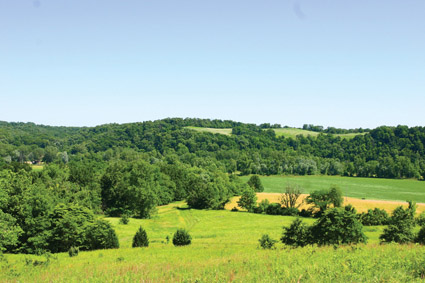 All whitetail junkies fantasize about owning land that produces monster bucks. This pipe dream becomes a reality for more bowhunters every year. Could you be one of them?
All whitetail junkies fantasize about owning land that produces monster bucks. This pipe dream becomes a reality for more bowhunters every year. Could you be one of them?
The big obstacle for most of us is money. The going rate for hunting land runs from about $1,800 to $4,000 per acre, says Brian Murphy, wildlife biologist and CEO for the Quality Deer Management Association (QDMA). It doesn’t take many acres to add up to a hefty sum.
Investment
If you treat hunting land as an investment, the cost doesn’t seem as daunting. Interest rates are at historically low levels, which makes this a good time to acquire property.
Land is sure to appreciate over time, provided you buy wisely. Should the land near yours become developed, the increased value of your property could be substantial. This would afford an opportunity to sell your land at a profit and use the money to invest in a larger piece of whitetail heaven elsewhere.
The cost of prime farmland has jumped due to rising crop prices. In the past, the fertility of tillable soil and the maturity of the timber on rural lands determined its value. Acreage that couldn’t be farmed or had poor timber was relatively cheap and a bargain for hunters.
However, over the past 10 years or so, the increasing demand for hunting property has jacked up the cost of these “scrap lands.” Another factor is the quality of the whitetails that live on the land. You need big bucks to buy property that teems with big bucks.
If you don’t have deep pockets, you can grow trophy bucks by applying QDMA practices to your land. You’ll soon have quality bucks to hunt and land that’s worth far more than you paid for it. When you find a place that looks promising, check to see what land nearby sells for before you make a bid.
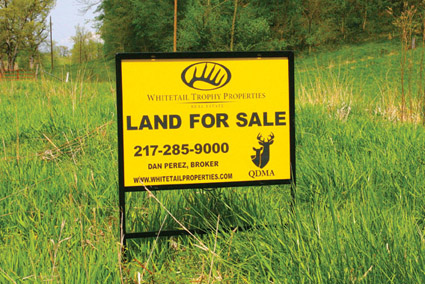 Most lenders require a down payment of 25 percent for vacant land purchases, points out avid bowhunter Brooks Purdy, an Athens, Ohio, realtor who specializes in hunting properties.
Most lenders require a down payment of 25 percent for vacant land purchases, points out avid bowhunter Brooks Purdy, an Athens, Ohio, realtor who specializes in hunting properties.
“You can reduce the percentage of the down payment by purchasing a property with a house or cabin on it,” Purdy says.
A building also adds to the value of the land, and it provides a place to stay during your hunting ventures. “If you can afford to invest in land now, it’s a great time to be a buyer,” Purdy says. “You have a lot to choose from.”
Location
Where should you buy your piece of whitetail heaven? That depends on your goals. Are you dead-set on bowhunting where giant whitetails roam? Then Midwestern states that have proven big-buck genetics are your best bet, including Illinois, Indiana, Missouri, Iowa, Nebraska, Kansas, and Ohio.
Then again, if you live a long distance from the Midwest, will you be able to travel several times a year to hunt and manage property you purchase there? It would be terribly frustrating to make payments on land you rarely visit.
If you wish to buy land in a state where you don’t reside, check its hunting regulations. Be sure that you, your friends, and family can buy nonresident hunting licenses and deer tags over the counter. Otherwise, you might have to enter a drawing for deer tags to be eligible to hunt your own property.
You may prefer to buy land within an hour or two’s drive from home. Although your state may not grow the biggest bucks in North America, QDM can produce Pope & Young-class bucks just about anywhere.
Land near major cities is generally more costly and has been divvied into smaller parcels. However, the right 5- or 10-acre plot could put you in bow range of suburban whitetails that see little hunting pressure and live long enough to grow big antlers. An ideal situation would be a wooded bottleneck that separates crops from a sanctuary where hunting isn’t permitted, such as a golf course or metro-park.
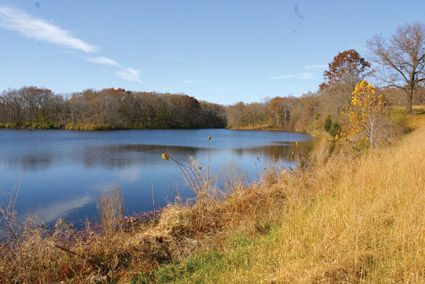 You won’t be able to manage suburban deer, and you’ll probably have to put up with the din of traffic, barking dogs, and other incessant background noise. But, in recent years, many of the biggest whitetails registered in the Pope & Young Club’s record book have been tagged on the fringes of large cities.
You won’t be able to manage suburban deer, and you’ll probably have to put up with the din of traffic, barking dogs, and other incessant background noise. But, in recent years, many of the biggest whitetails registered in the Pope & Young Club’s record book have been tagged on the fringes of large cities.
In rural areas, keep in mind that adjoining lands dramatically influence the deer population on any given piece of property. Acreage that abuts a large public hunting area gives you immediate access to more land. That may sound good, but the downside is that your property will be overrun by hunters that trespass from the public land.
Nearby farmland can be beneficial, provided that over-hunting is not an issue. The crops supply an abundant food source for whitetails that bed on your property,
Heavy hunting pressure on adjacent lands that do not receive QDM will take a toll on immature bucks that wander over from your property. A real diamond would be a place that’s encircled by property where the owners are seriously into QDM. You’re assured that trophy bucks are already established and that your management efforts will pay off.
Size
The ultimate fantasy is to own enough land to contain the natural movements of the whitetails that live on it. On this whitetail Mecca, your QDM efforts would reap their full benefit and big bucks would abound. The reality is that it would require several thousand acres and carry a price tag that would make Donald Trump balk.
This isn’t to say that smaller tracts are a waste of money. Many trophy bucks are taken on hunting grounds of 100 acres or less. However, small parcels must be situated where they take advantage of good whitetail habitat on adjoining lands. In some instances, neighbors agree to practice QDM, which improves the trophy potential for everyone involved.
If you can find a natural funnel between a major bedding and feeding area, a 10- or 20-acre plot can be a gold mine. A hunter from Mississippi bought a 20-acre parcel in Illinois from Dan Perez, a broker with Whitetail Properties and host of the Whitetails Properties TV show on the Sportsman Channel.
The land was a corridor that joined two large tracts of timber to farmland. The Mississippi buyer killed an Illinois whitetail on his land that scored over 200 the first year he hunted there. His trail cameras also caught several other big bucks crossing over his property. In the spring, gobblers filed through five and six at a time. A good way to gain access to larger tracts of trophy whitetail habitat is by joining a co-op of like-minded hunters, points out Perez.
“If 50 acres is all you can afford, why not join forces with other guys and buy 300 acres,” he says. “This works well when all co-op members are on the same sheet of music in regard to QDM.”
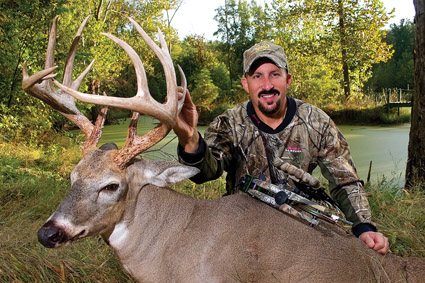 Perez compares joining a co-op to buying a home in an exclusive subdivision. On rare occasions, there’s an opportunity to buy a piece of an existing co-op that has a reputation for producing trophy whitetails. Although it’s usually pricey, it sells fast.
Perez compares joining a co-op to buying a home in an exclusive subdivision. On rare occasions, there’s an opportunity to buy a piece of an existing co-op that has a reputation for producing trophy whitetails. Although it’s usually pricey, it sells fast.
Perez often works with a group of hunters to create a limited liability company (LLC) that establishes a co-op for hunting purposes. He directs hunters who wish to invest the same about of money in a co-op to attorneys who can draft the legal documents.
“The key to making a co-op work is to spell out every detail in the operating agreement,” Perez says.
For example, what should be the minimum size for killing a buck? One hunter might think a 130-class buck is a trophy, while another wants a 150 minimum. Other things to consider are how many guests each member is allowed let hunt and how food plots are to be managed and paid for. Get everything in writing. This ensures that you know exactly what you are getting into, and it averts hard feelings down the road.
Perez and some of the other realtors who specialize in hunting land also offer turnkey properties that have been managed for quality deer and already support trophy bucks. The realtor typically purchases property that has potential but needs work. Then he plants food plots, creates sanctuaries, and erects fencing and gates where needed. Trail cameras photograph the bucks as they mature.
“When we sell the property, we show potential buyers photos of the bucks that are living there,” Perez says. “It’s like a prospectus for an investor.”
Where To Find Land
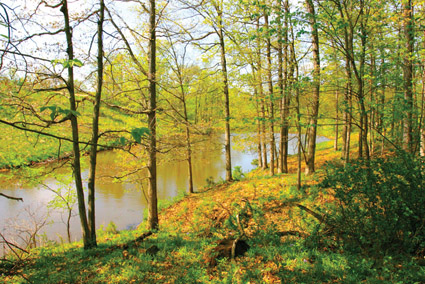 Check the classifieds of newspapers in the region where you wish to buy land. Here you might find something of interest from a private seller. Local realtors will surely have listings that offer hunting potential.
Check the classifieds of newspapers in the region where you wish to buy land. Here you might find something of interest from a private seller. Local realtors will surely have listings that offer hunting potential.
An Internet search will turn up many realtors who specialize in hunting property. Here are some of the ones I found:
Awesome Antler Farms
Buy Wisconsin Land
Cabela’s Trophy Properties
Hunting Pro Properties
Hunting Property Search
Jackson & Associates
Land and Game Company
Midwest Whitetail Land Company
Ohio Hunting Properties
Trophy Whitetail Property, LLC
Whitetail Properties
Habitat: Buy It Or Build It
Wherever you buy property, it must have habitat that is conducive to growing and holding trophy bucks. If the land hasn’t been managed for whitetails, a mix of mature hardwoods, brushy cover, and tillable soil for food plots gives you a lot to work with. A stream or some other water source ensures that your deer won’t have to go elsewhere to quench their thirst.
Then again, if the property is in the right location, you can turn just about any land into prime whitetail habitat if you’re willing to invest the time, effort, and money into QDM, claims Perez.
“Sometimes you’re better off starting from scratch so you can put everything where it needs to be,” he says.
An essential feature is a sanctuary that’s off limits to humans, stresses Perez. This provides bucks with a place where they rarely, if ever, get a nose full of human scent. We’ll get into more details in Part II: Managing Your Whitetail Property. (See the October 2011 edition of Bowhunting World.)






